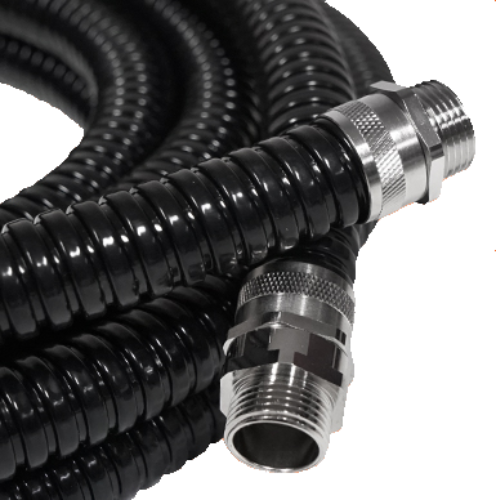
This free, helpful guide explains all the different types of flexible conduit, and should answer the question, What Flexible Conduit Should I Use ?
Flexible Conduit
Flexible conduit has been in use for many years and is still a popular choice for applications that require movement or flexibility. It is made from various materials, including plastic, rubber, and metal, and can be used indoors or outdoors.
A flexible conduit is heavy-duty galvanized steel or plastic tubing with threaded connections. It’s generally used outside to avoid damage and support electrical cables, panels, and other equipment.
Flexible conduit is used often in the construction industry. It can be used to run electrical wiring through tight spaces or around corners, which would be difficult or impossible with traditional wiring methods. In this article, we’ll look at the different materials used in flexible conduit.
Metal Flexible Conduit Gland

Plastic Flexible Conduit
Plastic flexible conduit is made from thermoplastic materials, including PVC (polyvinyl chloride) and PE (polyethylene). It’s the most common type of flexible conduit and is available in a variety of colors.
Conduit systems are frequently utilized to surround wires, reducing the danger of electrical hazards such as electrocution. Plastic conduits, for example, are encased in a waterproof plastic covering that guards cables against water damage.
Some specs of flexible plastic conduit include:
- Made of Polypropylene
- Impact Resistance: Light 1 Joule at 5°C
- Coil Length of 10 Meters
- The thickness of 20mm to 25mm
- Temperature Range: -5°C to 90°C
- Protection Rating: IP44-IP46
One advantage of a flexible plastic conduit is that it’s lightweight and easy to install. It can also be easily bent to fit around obstacles. However, it’s not as durable as a metal flexible conduit and may not be suitable for use in areas with high traffic or exposure to harsh weather conditions.
The advantages of plastic flexible conduit include:
- Lightweight and easy to install
- Can be easily bent to fit around obstacles
- Suitable for use in areas with high traffic or exposure to harsh weather conditions
The disadvantages of plastic flexible conduit include:
- Not as durable as metal flexible conduit
- May not be suitable for use in areas with high traffic or exposure to harsh weather conditions.
Plastic Flexible Conduit Contractors Pack

Metal Flexible Conduit
Metal flexible conduit is made from galvanized steel tubing with a zinc coating. This type of conduit is more durable than plastic flexible conduit and can withstand harsh weather conditions. It’s also less likely to corrode over time. However, metal flexible conduit is heavier than plastic flexible conduit and can be more difficult to install.
Sizes available in this product range are as follows, 12mm, 16mm, 20mm, 25mm, 32mm, 40mm, 50mm,
Some specs of metal flexible conduit include:
- Length of 10m – 50m
- The thickness of 16mm – 50mm
- Protection Rating: IP54
- Temp range -20 °C to +80 °C
Metal flexible conduit is suitable for use in systems for electrical power, communication cables, motor leads, listed assemblies, wire fixtures, and manufactured wiring systems.
Metal conduit is a good choice for applications that require a high degree of protection from the elements, such as outdoor wiring.
The advantages of metal flexible conduit include:
- Metal flexible conduit can withstand harsher weather conditions.
- It’s less likely to corrode over time.
- Suitable for use in systems for electrical power, communication cables, motor leads, listed assemblies, wire fixtures, and manufactured wiring systems.
The disadvantages of metal flexible conduit include:
- Heavier than plastic flexible conduit.
- Can be more difficult to install.
Metal Flexible Conduit

Which is Better – Metal or Plastic Flexible Conduit?
Both plastic and metal flexible conduits have their pros and cons. Ultimately, the type of conduit that’s best for your application depends on your specific needs. If you need a lightweight, easy-to-install conduit that can handle moderate weather conditions, then plastic flexible conduit is a good option. If you need a more durable conduit that can withstand harsher weather conditions, then metal flexible conduit is a better choice.
When choosing a type of flexible conduit, it’s important to consider the following factors:
- The weight of the conduit
- The ease of installation
- The durability of the conduit
- The temperature range the conduit can withstand
Depending on your application, you may also want to consider using a combination of plastic and metal flexible conduits. For example, you can use plastic flexible conduit for runs that are less likely to be exposed to weather, and metal flexible conduit for runs that are more likely to be exposed to the elements.
Conclusion
Flexible conduit is a type of tubing that’s made from either plastic or metal. It’s used to protect electrical wiring from damage and to help keep the wiring organized. Flexible conduit can be bent and twisted to fit around tight corners, making it a versatile option for many different applications.
Plastic flexible conduit is typically made from polyvinyl chloride (PVC), while metal flexible conduit is typically made from galvanized steel. Both types of conduit are available in a variety of diameters, depending on your needs. The conduits are also available in a variety of lengths, depending on the application.




